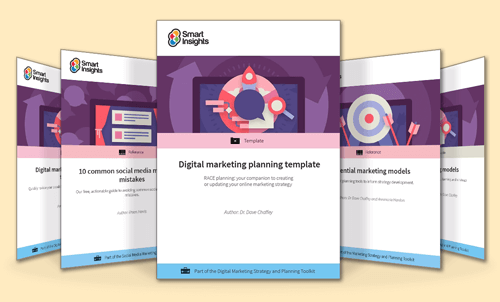What is e-commerce marketing and how is it different from other digital marketing? Discover opportunities for strategic optimization in an industry which has seen year on year growth like no other
2020 was the year of e-commerce. You don't need me to tell you that. Over the last decade, our marketing technological ability and sophistication have gradually improved, enabling increased e-commerce engagement and traction, as more businesses have begun selling online.
However, it's the rapid change in social behavior during the global pandemic that is responsible for the peaks we've seen this year - such as e-commerce accounting for 16% of total sales in the US in Q2 2020.
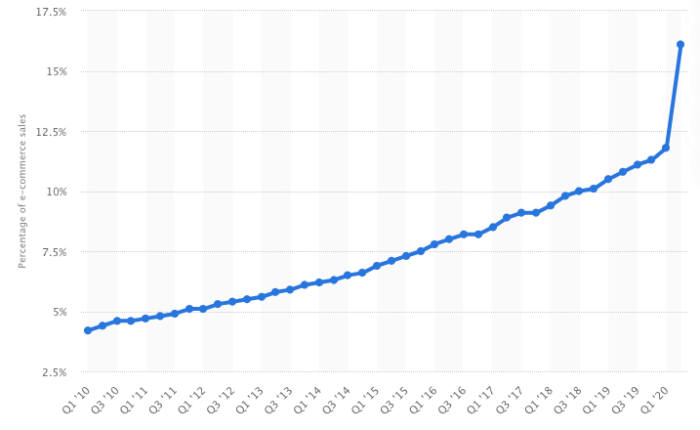
Identify, anticipate and satisfy customer requirements profitably, online
So, your customer wants to buy from you online? Great. But how is e-commerce marketing any different from any other sector?
E-commerce, or electronic commerce, is a marketing definition given specifically to commercial transactions (of goods or services) that take place online. This could be an online trader, a bricks-and-mortar business owner with an e-commerce website, or multi-corporations that sell online. E-commerce, from the customer's point of view, means they can buy from the comfort (and, this year, safety), of their own home.
So, when considering e-commerce marketing in relation to other disciplines, I find the CIM definition of marketing useful. E-commerce is still marketing, but, here, the transaction takes place online.
“ Marketing is the management process responsible for identifying, anticipating and satisfying customer requirements profitably.”
So, e-commerce marketing is all about knowing your customer and satisfying their needs, when they make a purchase online.
Optimize your e-commerce marketing strategy with the RACE Framework
The RACE Framework will help you or your team to implement digital marketing practices effectively within your organization by planning, managing, and optimizing your digital media, digital experiences, and digital data.
We created the RACE Framework as a strategic planning system for marketers, structured across the customer lifecycle of reach, act, convert and engage. In this article, we will outline opportunities for e-commerce optimization, so you can reach and convert even more of your online customers to boost your online sales.
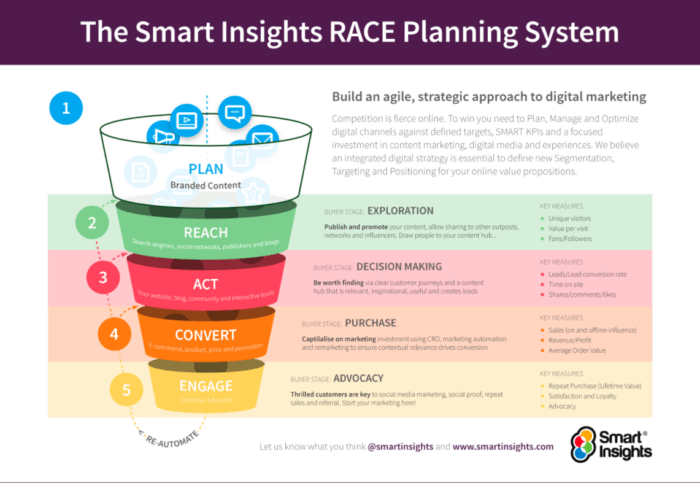
Looking to streamline your e-commerce marketing strategy to win more customers? We've got frameworks and tools to support you to integrate your marketing activities and optimize your strategy to win more customers. Find out more.
Is your E-commerce or Retail business competing online?
With so much competition, you need to stand out. Use the RACE Growth Process to win more customers
Get started now
1) REACH: E-commerce marketing
As many smaller e-commerce marketers will know - the first challenge is being discovered. In the startup phase, it's not uncommon to find a lower ROI on your Reach marketing while your brand is being established.
Optimize your content for high purchase intent search engine queries
You're making the process much, much harder for yourself if you haven't got a solid SEO strategy to reach your customers. At Smart Insights, we generate 80% of our web visits from organic traffic (and a fair amount of conversions too!). This low-cost opportunity may take a little longer to generate traction, but the long-term benefits are invaluable.
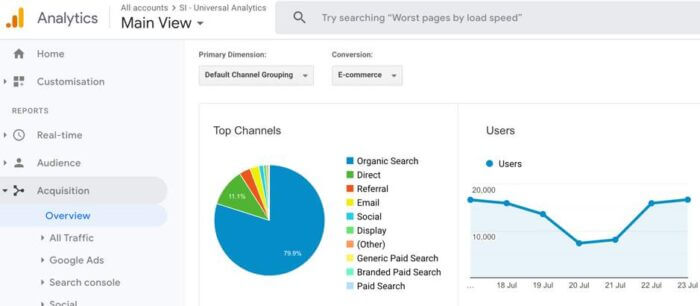
As an e-commerce marketer, your #1 priority is attracting engaged traffic onto your website with high-quality content that answers their questions and gives them what they want. The key to that is understanding consumer keyword search behavior.
Optimize your digital and social media strategy
To optimize your digital and social media for e-commerce reach, consider the role of paid, earned, and owned media:
- Paid media - Paid adverts where an ad is placed online or offline with the goals of increasing brand awareness, acting as a reminder, or encouraging click-through to a website or app.
- Owned media - Owned by the brand, online this includes a company’s own websites, blogs, email list, mobile apps, or their social presence on Facebook, LinkedIn, or Twitter. Offline-owned media may include brochures or retail stores.
- Earned media - Traditionally, publicity generated through Public Relations invested in targeting influencers or partner sites (co-marketing) to increase awareness about a brand. Also, includes word of mouth, stimulated through viral and social media marketing, and conversations in social networks, blogs, and other communities.
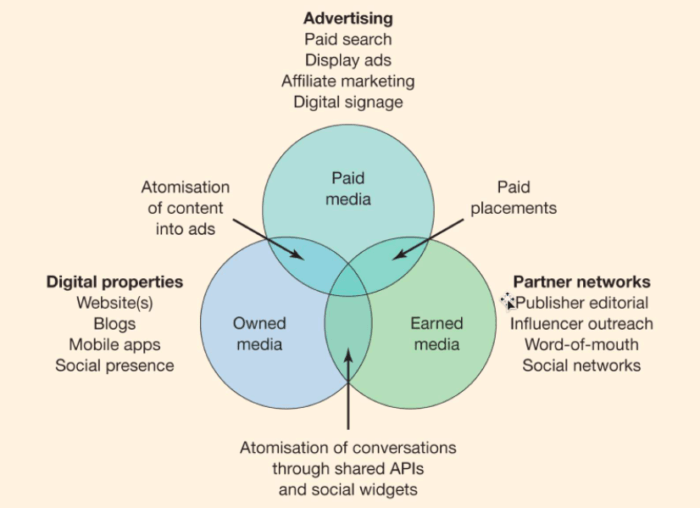
As we've seen, selecting the right balance of media investments can help you increase your reach amongst your target audience. By taking a strategic approach to digital marketing channel management, e-commerce retailers can enhance their omnichannel marketing to reach and convert more customers online this year.
Recommended reach marketing tools
We've got tools and training to help you increase your e-commerce reach. Our SEO and Campaign Planning Learning Paths will support you and your team with those all-important tactics to get your products in front of the right audience.
All our Learning Paths are integrated across the RACE Framework, so you can be confident that your e-commerce customers' lifecycle is being fully optimized to accelerate your ROI. Find out more.
Is your E-commerce or Retail business competing online?
With so much competition, you need to stand out. Use the RACE Growth Process to win more customers
Get started now
2) ACT: E-commerce marketing
Once you've got them to your website, your role as an e-commerce marketer is to help customers find products that delight them and encourage them to act.
Optimize customer-centric naming conventions
Remember, your customer has come to your website to complete a task. As such, your e-commerce naming conventions should be designed to help them with this - clear, informative, easy to navigate. Here are some examples of over-complicated naming conventions:

‘Inspired Living’, for example, communicates nothing to the user about the category. Instead, descriptively named categories such as 'Appliances' or 'Kitchen Planning' help guide the user towards what they are searching for.
For users who have navigated to a particular page through a keyword search, it's crucial to ensure the page in question quickly answers their question to nurture conversion and avoid bounces.
Optimize 'New' products through categories or filters
If you have a lot of return visitors and customers then chances are your conversion rates could benefit from having a ‘What’s New’ section in your e-commerce website.
This is simply a category filter that allows users to see what new items have been added throughout the store since they last visited. Having this category or filter stops the users from having to visit multiple pages and search using their memory for new items or products. This is especially useful in seasonal industries like fashion, where seasonal items are released throughout the year.
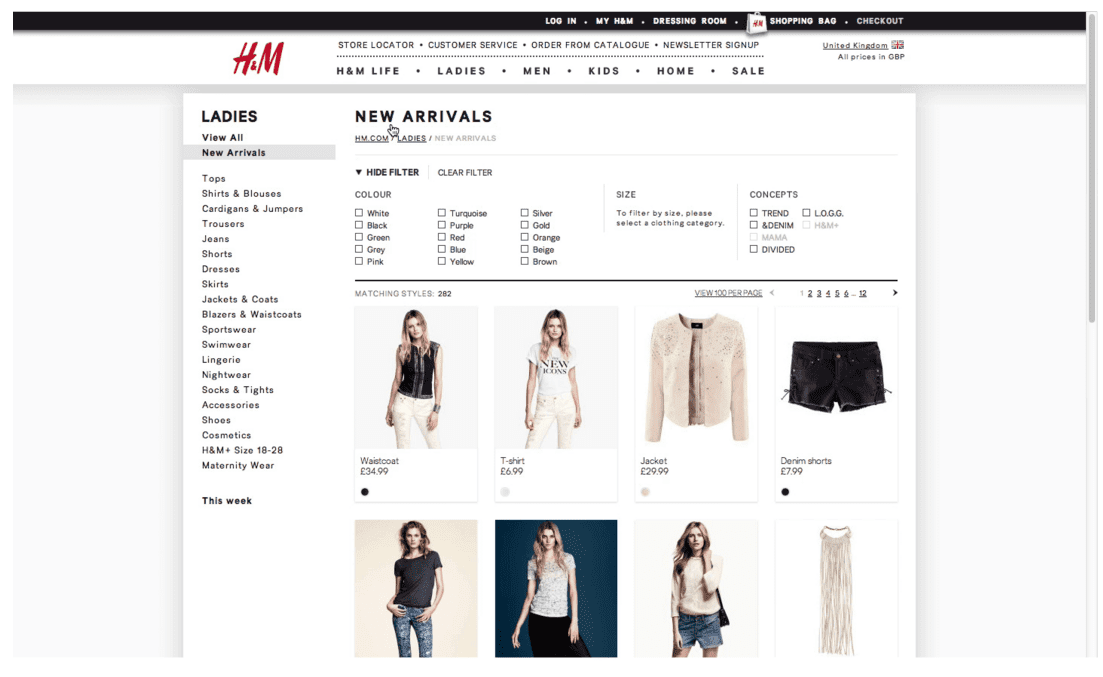
Taking a customer-centric approach to your e-commerce website will help you meet business and customer goals, improving the overall effectiveness of your website customer journeys.
Recommended act marketing tools
We've got tools and training to help you increase your e-commerce interaction. Our Digital Experience and Content Marketing Learning Paths will equip you and your team with solutions to offer your customer a seamless customer experience and make it as easy as possible for them to purchase (and repeat purchase) from your store.
All our Learning Paths are integrated across the RACE Framework, so you can be confident that your e-commerce customers' lifecycle is being fully optimized to accelerate your ROI. Find out more.
Is your E-commerce or Retail business competing online?
With so much competition, you need to stand out. Use the RACE Growth Process to win more customers
Get started now
3) CONVERT E-commerce marketing
By the nature of the business, e-commerce retailers can measure the entire customer journey from the top to the bottom of the sales funnel - using metrics like conversion rate, revenue per session, and more.
Conversion Rate Optimization
Conversion Rate Optimization (CRO), is a structured testing and optimization process aimed at improving key performance indicators for a website.
A hypothesis in CRO projects typically states the benefit that you expect a change to deliver. Here are some examples of what you can test on an e-commerce website:
- Your primary value proposition or campaign message
- Product category or filter changes
- Product imagery
- Call to Action buttons
- Lead gen forms and other forms on the site
The Convert stage of the funnel is all about increasing customer conversions through data-driven design, so, if you want to make sure your e-commerce website is as effective as it can be at converting customers, use A/B tests or multivariate tests to generate insights and optimize your marketing strategy.
Optimize A/B testing
A recent case study with Buyakilt demonstrated a 76.1% increase in revenue and 26% increase in conversions when A/B testing product filters on their category pages.
If a user can’t filter to find their dream product, they won’t be able to buy it! So, e-commerce marketers must consider the role of all UX site design aspects within the Convert stage of their marketing strategy.
Business Members can access our 'How to do A/B tests with Google Optimize' Quick Win, which is a 60-minute resource covering the basics of this testing process in this popular, free platform.
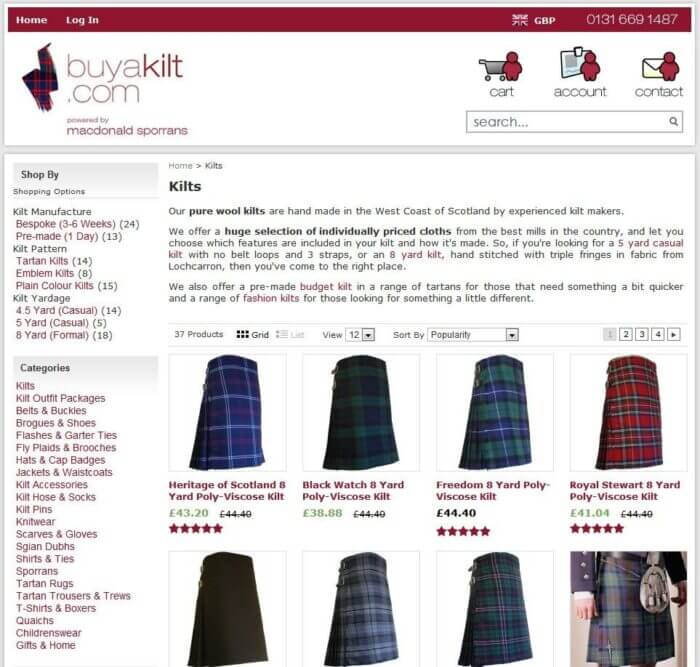
Optimize your breadcrumbs
We know using breadcrumbs can increase your shop's usability and conversion rates. There are three main types of breadcrumb:
- Location-based
- Attribute-based
- Path-based
The type we are most concerned with for e-commerce stores is location-based bread crumbs. These breadcrumbs are used for navigation schemes that have multiple levels (like e-commerce categories):
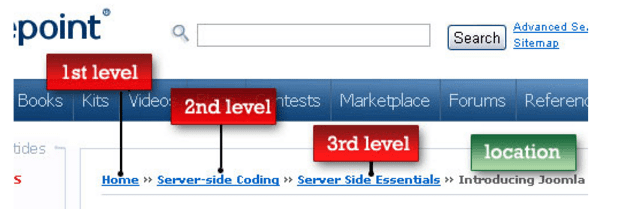
Breadcrumbs are great for improving user experience because they are:
- Convenient modes of navigation for users
- Reduce clicks to return to higher-level categories
- Don’t take up a lot of screen real estate
- Reduce bounce rate by improving findability
Top e-commerce tips for using breadcrumbs:
- Use ‘>’ to separate the levels in your product hierarchy
- Put crumbs at the top of the category page
- Make sure to differentiate your breadcrumb font styling, to improve their ranking in the visual hierarchy - otherwise, people won’t find them
- Don’t use them as the primary navigation
- Always show the whole path back to the top-level category
- Use full page titles where possible so the breadcrumbs correlate to the pages and reassure the user they are in the right location
Optimize product pages
When shopping online, visitors can’t touch or feel your products like in the real world. Therefore, it is really important to provide them with the best product pages possible to makes up for this shortcoming. You should be able to zoom in on products to see the details and the imagery should be contextually relevant.
Finally, the images should be consistent in their lighting, backgrounds and post-production.
OVO Things does a great job of this:
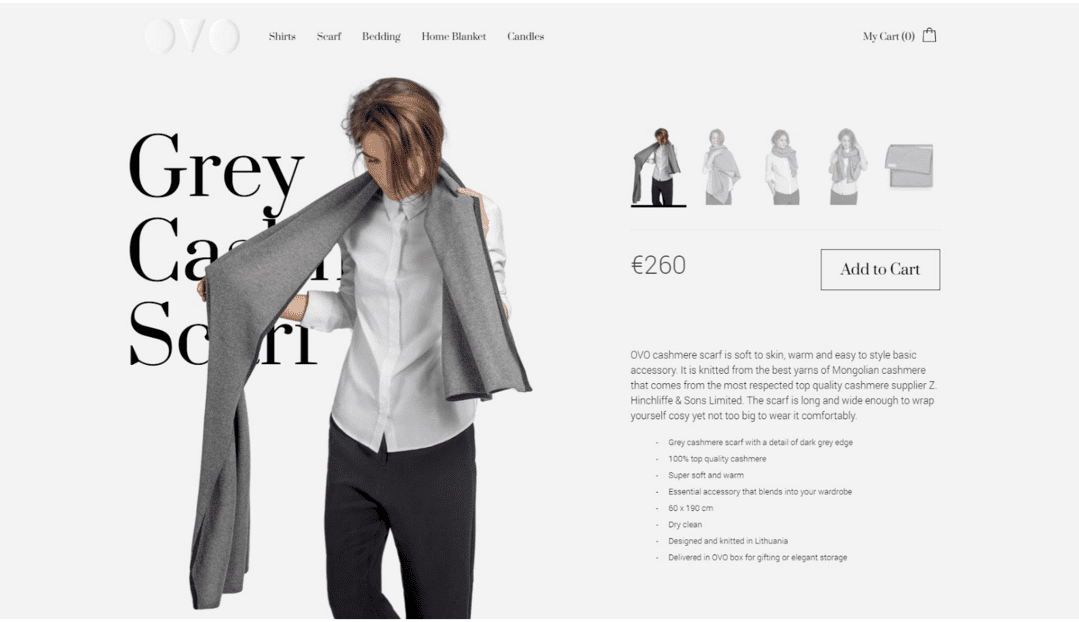 As a clothing brand, it is essential to show the clothes on a person, just as a furniture store should show the pieces within an interior environment.
As a clothing brand, it is essential to show the clothes on a person, just as a furniture store should show the pieces within an interior environment.

You can also zoom the images to full screen on the OVO Things store allowing you to see the product in detail. It’s also important to show the product from different angles and perspectives. For e-commerce retailers, the importance of your product pages as a key conversion tool for your business cannot be underestimated, don't skimp here!

Checklist for making sure your product images are looking their best:
- Use high-quality imagery
- Create large images that can be zoomed
- Use consistently styled images
- Show the product in use contextually
- Display different angles and perspectives on the product
- Don’t let the image kill the value proposition or messaging of the sales page
- Use people in your photos when relevant
Recommended marketing tools to convert more customers
We've got tools and training to help you increase your customer conversions. Our Digital Experience and Google Analytics Learning Paths will equip you and your team with data-driven solutions to optimize your key converting pages and win more customers.
All our Learning Paths are integrated across the RACE Framework, so you can be confident that your e-commerce customers' lifecycle is being fully optimized to accelerate your ROI. Find out more.
Is your E-commerce or Retail business competing online?
With so much competition, you need to stand out. Use the RACE Growth Process to win more customers
Get started now
4) ENGAGE E-commerce marketing
Engage happens after your customer has made their first purchase. As we know, customer retention can save you up to 5x the cost of acquiring a new customer, so, keeping your customers loyal and engaged is a wise growth strategy for any marketer. This is particularly true in e-commerce, where your customer's lifetime value could be much higher than their first purchase.
Optimize customer onboarding
Your customer onboarding program should define activities which both meet business goals for onboarding and improve the customer experience, so increasing their satisfaction and then loyalty.
Common online customer onboarding activities include:
- Encouraging initial and repeated use of an online service
- Welcome emails
- Product registration
- Post-purchase support
Implement these tactics to support your customers through their adoption curve, and reap the rewards of having a satisfied customer base:
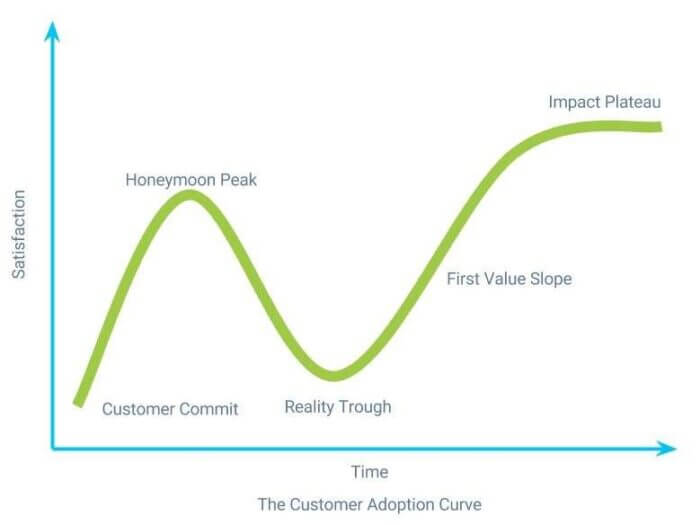
But it's not just your customers' spending value that makes engage such a valuable process for e-commerce. Satisfied customers can become advocates for your brand, which in turn increases your reach. Optimize your customer onboarding processes to reap the reward of a loyal fanbase, extended reach, and a lower ROI.
Optimize social proof
One of our top 5 trends for social media marketing in 2021 demonstrates the true value of engaged customers through social proof.
"With studies showing that 75% of people don't accept advertisements as truth, there is a lot to be said for a relationship marketing approach to building trust with your social media audience. These stats speak for themselves:
- 63% of social media users feel consumer ratings are #1
- 70% of consumers believe customer opinions (more than double those who trust advertisements)
To cut through in 2021, social media marketers must invest in their relationships with customers to ensure our key brand messages are backed up by the voices our customers value the most."
So, for e-commerce marketers, your satisfied customers, as advocates, will feed the top of your funnel by recommending your products to their friends and family, leaving reviews, and boosting your pages' SEO rankings. It's a no-brainer!
Recommended marketing tools to convert more customers
We've got tools and training to help you retain more customers. Our Email Marketing and Automation and Social Media Marketing Learning Paths will equip you and your team with strategies and tactics for keeping customers engaged across the marketing mix.
All our Learning Paths are integrated across the RACE Framework, so you can be confident that your e-commerce customers' lifecycle is being fully optimized to accelerate your ROI. Find out more.
Is your E-commerce or Retail business competing online?
With so much competition, you need to stand out. Use the RACE Growth Process to win more customers
Get started now
Your e-commerce marketing strategy, and the RACE Framework
So as you can see, structuring your e-commerce digital marketing around the RACE Framework highlights a number of great opportunities for all aspects of selling your products online. We have a plethora of resources here at Smart Insights for members, proven to accelerate your digital marketing ROI and increase those all-important e-commerce conversions. Good luck!























